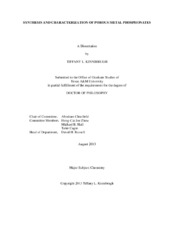| dc.contributor.advisor | Clearfield, Abraham | |
| dc.creator | Kinnibrugh, Tiffany Lewis | |
| dc.date.accessioned | 2013-12-16T20:03:14Z | |
| dc.date.available | 2015-08-01T05:48:30Z | |
| dc.date.created | 2013-08 | |
| dc.date.issued | 2013-07-26 | |
| dc.date.submitted | August 2013 | |
| dc.identifier.uri | https://hdl.handle.net/1969.1/151103 | |
| dc.description.abstract | This dissertation focuses on the challenge of developing porous metal arylphosphonates with both high crystallinity and functional porosity by using different synthetic approaches. Metal phosphonates are an extensive class of materials based upon extended inorganic-organic architectures such as chains, layers and three-dimensional networks. Metal phosphonates generally favor extended inorganic architectures leading to pillared materials with no porosity. We found that the use of template molecules, type of ligand and choice of metal ions could be used to deviate from the pillared structure. Many of these structures had interesting properties that were explored. The results can be divided into three areas:
We developed non-pillared monovalent metal phosphonates by investigating both the role of water and template molecules in the solvothermal synthesis. The role of water in solvothermal reactions was found to have a profound influence on the structure of monovalent metal phosphonates and the structures could be tailored from zero/one-dimensional to two-dimensional. Non-pillared structures could be synthesized by using template molecules.
For a zinc phosphonate, we converted a layered structure into a three-dimensional framework by using small template molecules in the solvothermal reaction. The compound exhibited reversible dehydration behavior. The change in the framework structure and guest positions was monitored during this process.
Two different ligands were used in the development of porous aluminum phosphonates. One series exhibited reversible dehydration behavior, which had a dramatic influence on permanent porosity of the material. The stability of the dehydrated phase is a result of the geometry of the aluminum atom, which in some cases has coordinatively unsaturated metal sites. The second series was developed with ion exchange applications in mind therefore the pore environment was tailored to favor ion exchange processes. The most important aspect is that these compounds exhibit high selectivity for Th^(4+) ions.
In total 28 new compounds were prepared, and their utility and structures clarified. | en |
| dc.format.mimetype | application/pdf | |
| dc.language.iso | en | |
| dc.subject | Metal phosphonates | en |
| dc.title | Synthesis and Characterization of Porous Metal Phosphonates | en |
| dc.type | Thesis | en |
| thesis.degree.department | Chemistry | en |
| thesis.degree.discipline | Chemistry | en |
| thesis.degree.grantor | Texas A & M University | en |
| thesis.degree.name | Doctor of Philosophy | en |
| thesis.degree.level | Doctoral | en |
| dc.contributor.committeeMember | Joe Zhou, Hong-Cai | |
| dc.contributor.committeeMember | Hall, Michael B. | |
| dc.contributor.committeeMember | Cagin, Tahir | |
| dc.type.material | text | en |
| dc.date.updated | 2013-12-16T20:03:14Z | |
| local.embargo.terms | 2015-08-01 | |


